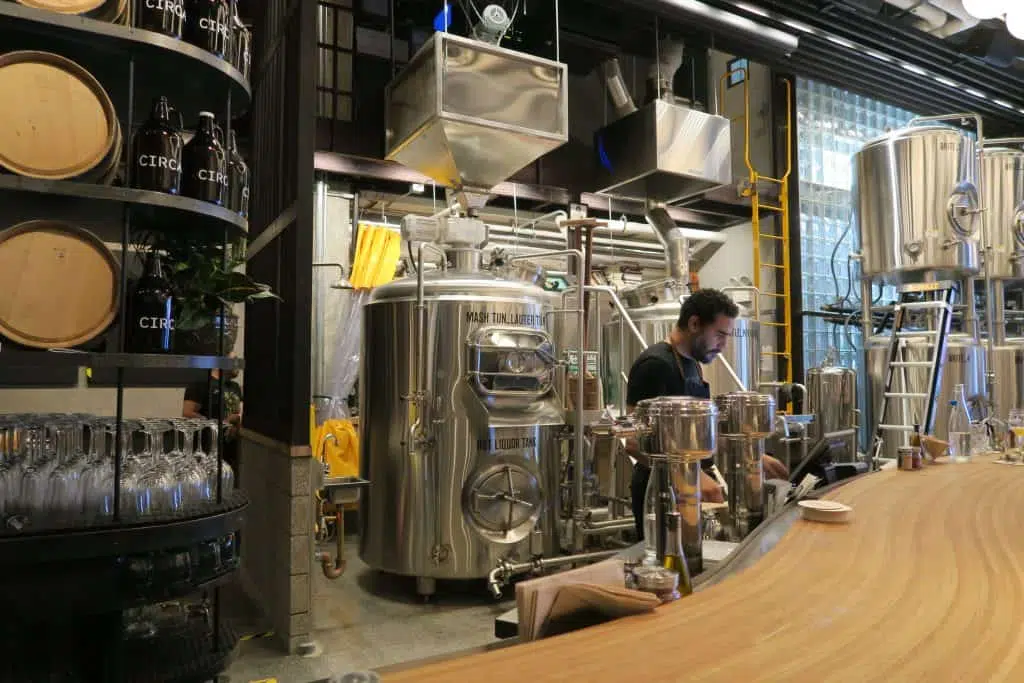The essential brewing process has not changed from when it was first practiced thousands of years ago. Anheuser-Busch, Interbrew, and Coors’s huge mega factories may dwarf some of their ancient predecessors, but the essentials are still the same.
To understand the modern brewing process, I paid a visit to a brew pub.
First, I will take you through the brewing process, all the way from grinding the grain until the beer is fermented and put into the finishing tanks.
Then, we’ll visit the “pub” part of the brewpub, and explore the different beer styles and how they go with food.
Brewing Day
Today is brewing day, and the sweet bread-like aroma of mashing may remind you of smells that teased you the last time you walked past a bakery.
In the past, this sort of establishment was not so rare. Two hundred or more years ago, the “house brew” was available at thousands of inns and hotels in Europe and to a smaller scale in North America. The brewer was usually the woman of the house, and the success of the inn or hotel surely rested heavily on her abilities to brew a tasty product.
A brewpub offers a look at the modern process of brewing beer on a small scale. Today, either a brewer or an alewife runs the brewpub. Their equipment has been developed over the last hundred years or so, except for the solid-state temperature and valve control . Still, the process is not essentially different from brewing thousands of years ago.
We will have to take a walk around to the back of the building. The size of the building is impressive for someone visiting their first brewery. You will have to keep in mind that this brewpub has a ten-barrel capacity. This means that the equipment can make 310 gallons of beer in one brewing cycle. Consider that a typical delivery to my favorite bar for beer is ten thirty-one-gallon kegs and perhaps thirty bottled beer cases. This comes to three hundred and ten gallons of kegged beer and sixty-seven and a half gallons of bottled beer. This is a weekly delivery when the owner does not complain about business. The brewery you are visiting can probably brew, condition (let it get ready for being consumed) and dispense the same amount. It will depend on consumer demand, of course. Still, the economics of brewing certain types of beers can mean the brewer is limited to either a different recipe or brewing less beer. The amount (Length) should be the capacity of the brewing equipment. The number and capacity of fermenters had to be considered in the original design of this brewhouse. I will explain which one is which when we go into the brewhouse.
Grain Storage
Harpoon Brewery, Windsor, VT (not a brewpub)
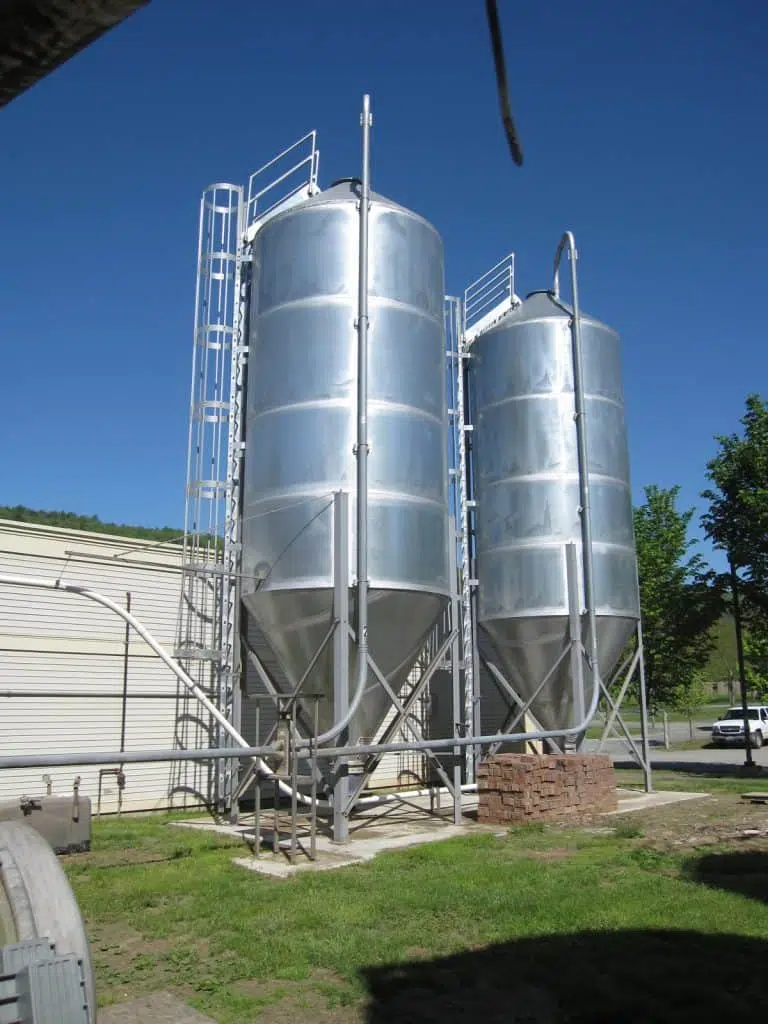
The first step in the brewing process is making sure you have enough grain on hand to not fall behind in production. You might recognize this first structure standing out here as a farm “silo” used to store cattle feed. You are not wrong. In fact, the only difference between this huge fellow and his agricultural cousin is that this fellow is not on the farm. However, this one’s contents will not be feed for cattle until the Brewmaster is through with it.
This brewery has an agreement with the local farm that they purchase the spent grain from the brewing process as feed for their cattle.
The attachment at the end of the cone-shaped bottom of the silo is part of a system that sends the grain up the grist mill.
The Grist Mill
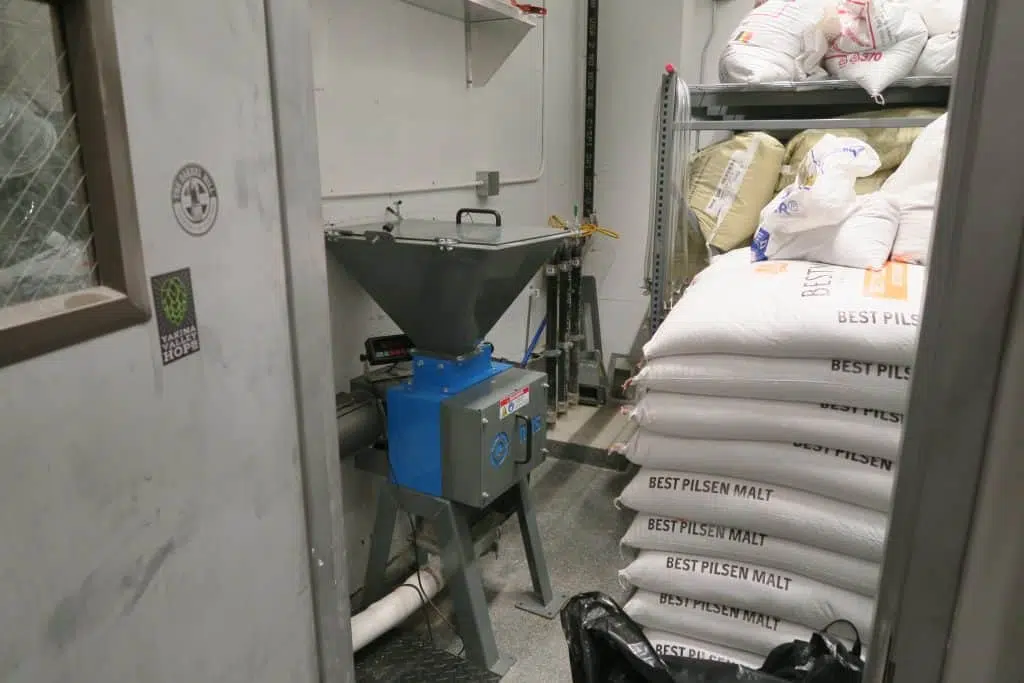
The grist mill is on the second story of the brewhouse. We can get up there by using the metal stairs that hug the building’s side but with enough room for two persons to pass safely. Through the door at the top of the stairs, we will watch the grist mill do its job. It gets its name from what it does to the grains that go through it. There are sets of crushing metal rolling cylinders. They are set so that they crush, not grind, the grains. This allows the brewer to get the most maltose (malt sugar) from these grains. The more of this sugar they can get, the more economical it is to brew their beer.
Here we are. Watch your step and put on the industrial ear mufflers you have been carrying and follow me.
The grist mill is a rectangular piece of metal machinery that sits in the middle of a gray cinderblock room. The grist mill here is relatively light-duty, in this instance. The brewer still uses the traditional open hopper when he wants to add a specially roasted grain to the grist. After being crushed by the rollers, the grain falls out of the grist mill down an opening on its way to the Mash Tun.
You can’t see the rest of the brewhouse because safety codes dictate that the grist mill is in an area where there is no, or low, the danger of the fine particles exploding. And should that ever happen, there must be the construction of protective walls, ceiling, and floor.
Through the large green metal door over there is another metal stair that will take us down to the brew house floor. It is really important to watch your footing. Although the floors are covered with a non-skid surface, there is still some standing water and spillage.
Pay particular attention to the hoses you will see. Sometimes they will take on a life of their own when moving liquids from one tank to another.
The metal stairs from the grist mill to the brew house floor are similar to those that took you from the base of the grain silo up to the mill.
The cluster of sizeable glistening silver and copper-colored metallic cylinders, some perched on sturdy metal legs, cone-shaped bottoms ending in valve ports that feed the thirsty snaking hoses, is so tightly packed you might wonder how the crew gets around. The similarity with a submarine ship as seen in the movies is remarkable.
Pausing halfway to the bottom of the stairs, you can see two of the crew connecting a red brick hose to one of the tall silver metal cylinders using silver couplers.
The Mash Tun
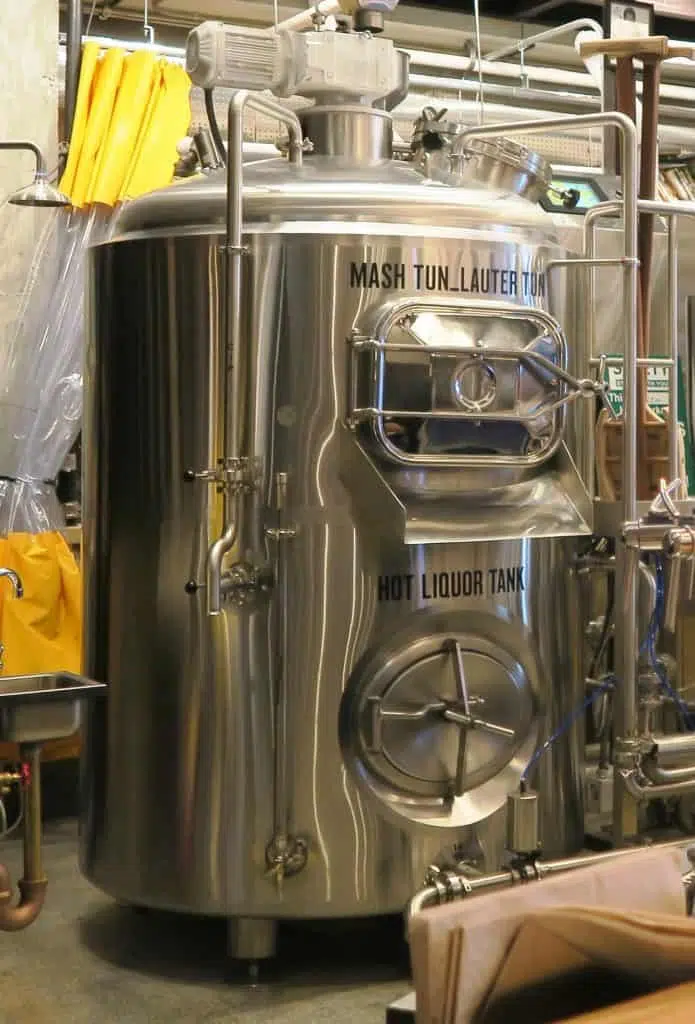
That not-so-tall squat, round stainless-steel vessel that looks to be part brick kiln and part industrial laundry washing machine is the Mash Tun. You can see where the pipe that carries the grain from the grist mill is attached to the ceiling and also where it is attached to the Mash Tun.
There is a set of metal steps that the brewer uses to reach a narrow catwalk that encircles the Mash Tun. A section of the upper metal structure has hinged doors that open to give the brewer a rectangular portal so that he has access to the hot wet grains in the Mash Tun.
Attached to the catwalk’s handrail, the brewer also has a board of glowing buttons; some of the glowing lights are red, and some are green. It is pretty humid, and there is steam rising from the space opened by the metal doors.
It is only a few steps up to the catwalk and a spot where you can look down into the Mash Tun. You can see the hot grain mush and watch as what seems to be a sturdy metal arm that extends from a central rod that goes from the top of the vessel to the bottom. This arm has wide flat metal arms that slowly slice through the mush.
The Brewmeister is telling you that the mush is called Mash and that it is being cooked for an hour or so at a temperature of 120F until the enzymes found naturally in the grain have converted all the starch in the grist to maltose, or malt sugar. He tells you that the board with the green and red lights is a communications system that allows him to know what is happening in the rest of the brewhouse. As you listen to the brewer speaking about the more technical aspects of the mashing process, the air’s aromas seem to change subtly. What was once a wet-grain smell has transformed into a sweeter fragrance, not unlike the welcome smells of a bakery. But don’t let your mind wander. There is still more to see, smell, climb up and down on, and always watch out for the hoses.
As you carefully descend down the stairs from the catwalk around the Mash Tun to the brew house floor, you notice that there is already a hose that is at least as thick as your arm attached to the valve at the bottom of the Mash Tun.
This hose is attached to a valve at the end of a silver pipe fixed to the side of a vessel similar to the Mash Tun. It also has a catwalk, rectangular opening in the side of the cone-shaped top and seems identical to the Mash Tun in every way.
Making sure not to step on the hose, you catch the Brewmeister’s following words as he gestures to this new vessel and calls it a Brew kettle.
The Brew Kettle
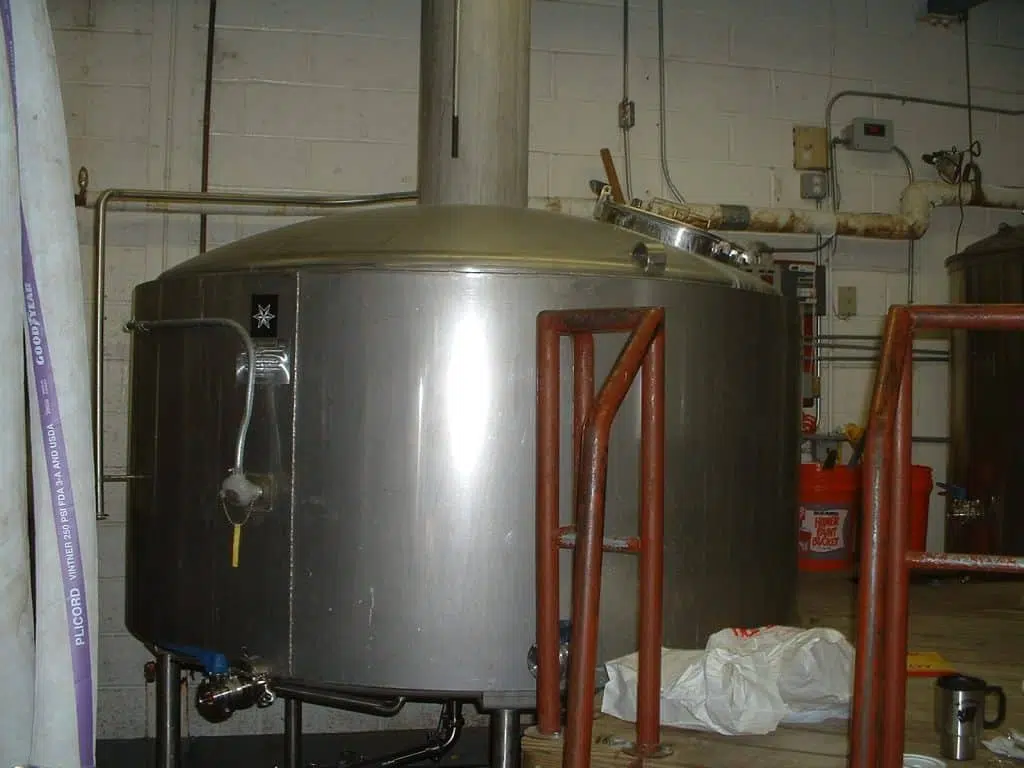
“Here is where the wort from the Mash Tun is piped so that we can get to the brewing part of the process.
This Brew Kettle holds over 300 gallons of hot wort that will be brought to a boil for an hour or so while we occasionally ad the hops to create our unique flavor profile. Most of our hops are grown in either the United States or other European hop-growing countries. Here we like the particular alpha acids that are unique to the…”
As the Brewmeister continues his comments on hops, you notice three large three-quart plastic containers with printed advertisements on their sides proclaiming that they contain the finest pasta salad made in this or any other city. The idea of all that pasta salad having something to do with beer brewing is not a thought to linger on. And this is when you hear the Brewmeister saying… “We use both hop flowers and hop pellets.” He pauses and pulls the top from two of the plastic containers. You can see that one contains thumb nail-sized dark green cone-shaped flowers. You can smell what you often associate with a field of new-mown hay or the scents that a woods offers to the breezes that follow a summer thunderstorm. The other container is half-filled with bright green pellets, not unlike what you have seen as food for pets.
To make sure you are not being unobservant, you lift the container of pellets and sniff at their aroma.
The sensation is like the cone-shaped flowers but has a hint of either spearmint or peppermint. But you don’t linger to explore the sensations as the Brewmeister has raised his voice to add emphasis to his instructions.
Wort Chiller
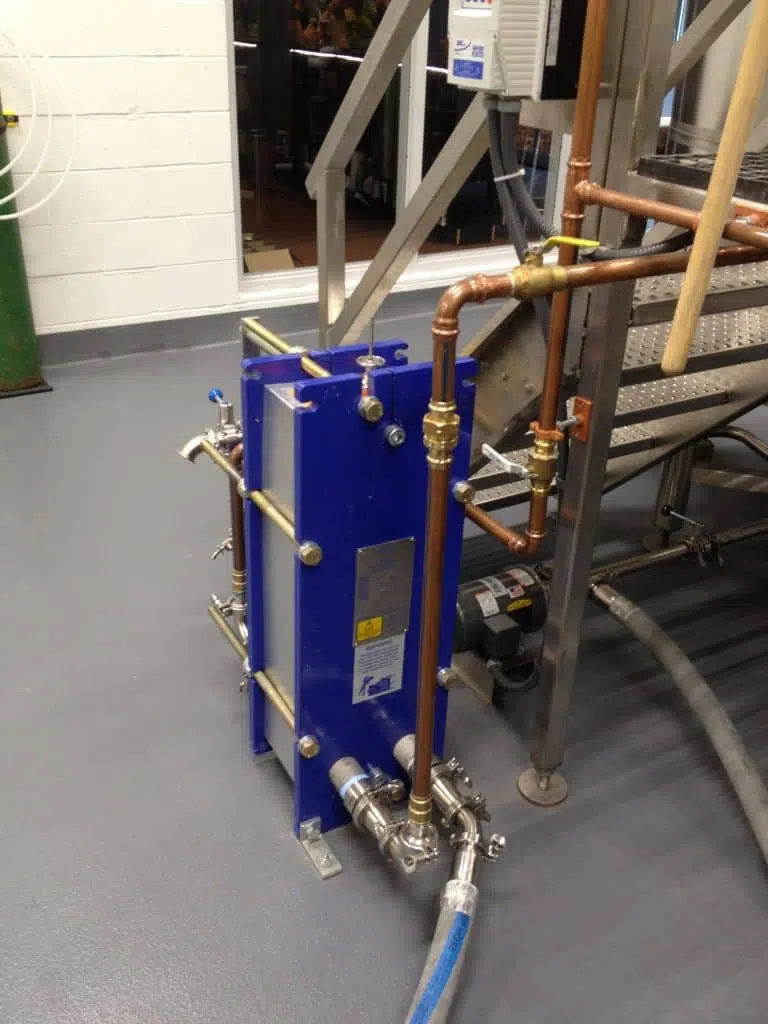
Almost hidden between the brew kettle and the fermenter is a piece of equipment that is a rectangular construction of thin metal plates with a plastic compact disk holder’s shape and thickness. These are heat transfer plates. They allow the heat to dissipate when the cold water chills the beer to the proper fermentation temperature. The leaves are atop a metal box that has two sets of hoses attached to it. One set of hoses are brick red in color. The other set is black and the thicker of the two sets. The metal box has a few valves and a dial that flashes numbers. These numbers tell the brewer the amount of wort that has gone through the chiller on its way to the fermenter.
The Fermenter
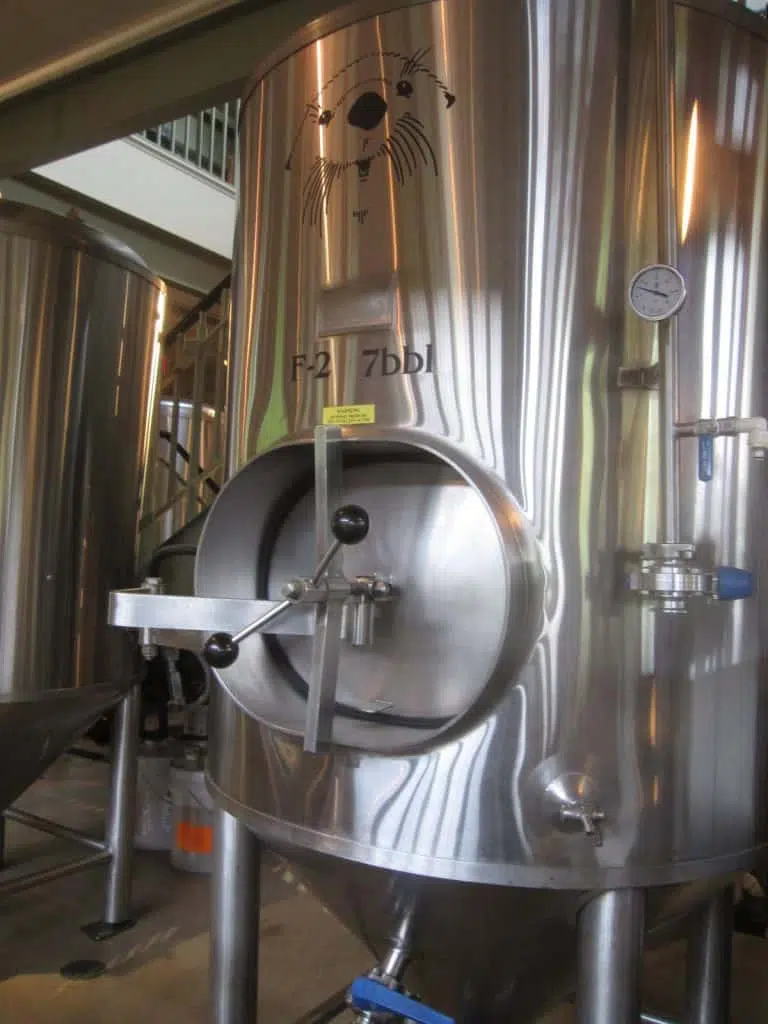
After the wort has been cooled to around 60°F, it is sent to one of the fermenters where the yeast is added or “pitched.” Whether it is an ale yeast or lager yeast, fermentation can take between two weeks to a month.
These huge metal cylinders perched upon four spindly legs with cone shapes at the bottom of them are the fermenting tanks. As you can see, each one of them also has a hatch in the side fitted to handle high pressures. The hatch allows the brewer or the brewers’ assistant to climb inside to thoroughly clean the tanks.
The cone-shaped bottom allows the yeast to settle out, if it is a lager, and makes it easier to retrieve the yeast if it is an ale.
This is where the beer ferments for at least one week. Since this brewery makes three different types of beer. That means they must have the capacity to ferment enough of that beer and keep it in the bright tanks.
These fermenting tanks are made of stainless steel and stand approximately 24 feet high. Each one of them can hold 30 barrels of beer, 660 gallons of beer, 2498 Liters. They have six fermenters here and six finishing tanks. We’ll get to the finishing tanks next.
Finishing Tanks (Bright Tanks)
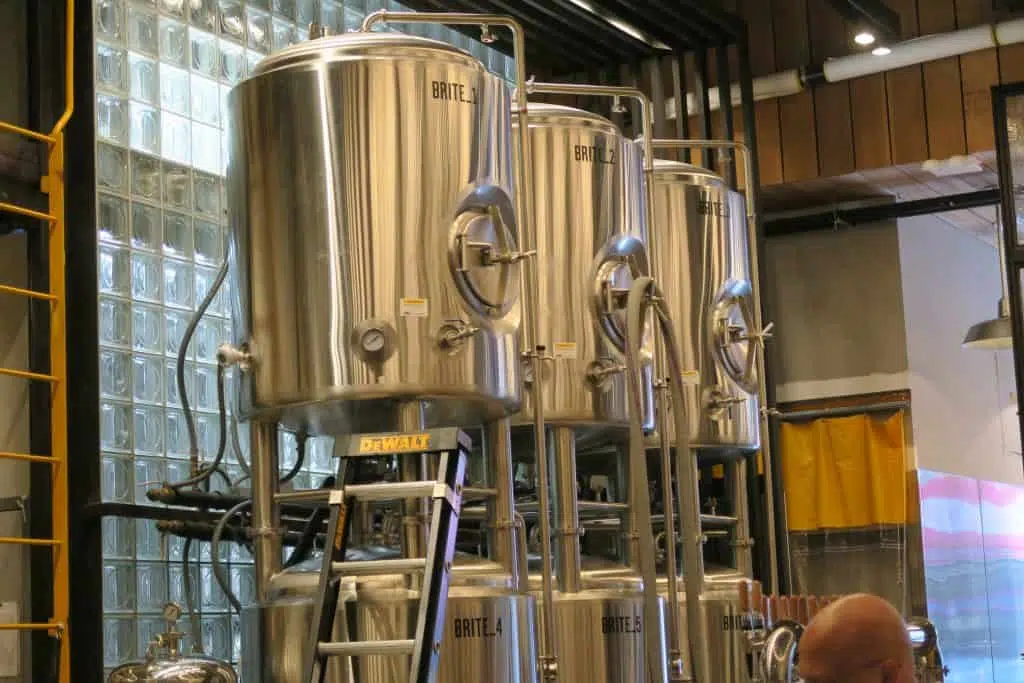
And finally, we reach what is called the finishing tanks. You can see the bar through the glass windows here. It makes a rather impressive sight from the other side, as you will see. These six finishing tanks look like mini fermenters. That is what they are. Here is where the ale or the beer is stored just before it is served. It goes through a secondary fermentation which allows for the carbonation. Natural carbonation gives the beer or ale a creamy flavor and feel in the mouth. There are two ways to carbonate beer.
The first way is to inject carbon dioxide into the beer using compressed carbon dioxide sent into the beer through a carbonation stone.
The second way is natural fermentation. This takes place in the finishing tanks. When an additional amount of yeast is added to the beer, so that it may continue fermenting.
Natural carbonation, created by the yeast in the secondary fermentation, results in smaller, more delicate bubbles that add more than just a nuance to the beer.
In most breweries, the finishing tanks are arranged to be as close as possible to where the bottling and the kegging line are. In a brewpub, the finishing tanks are situated as close as possible to where the consumers will be.
Many brewers call these tanks “bright tanks,” saying that they are smarter or less smart than any other tank because brewer’s jargon designates it the secondary fermentation tank.
The Pub Part of the Brewpub!
As you walk into the pub part of the brewpub, a good long bar is equipped with six taps and a clear glass window behind the bar that separates the world from the brewhouse we just came from. From this side of the glass, the squat silver cylinders we now know are the conditioning tanks, no longer look like a refinery or laundry. Since there are a few empty stools at the bar, it might be good to sample the house beers before we sample a few things from the menu.
Fore the full story click on the following link when it is available.

